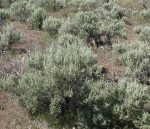 This evergreen shrub or small tree is native to the western US and Canada where it grows in arid and semi-arid conditions in cold desert, steppe, amd mountain habitats. It is also known as big sagebrush and Great Basin sagebrush, and is a member of the aster family, Asteraceae, that also includes daisy, yarrow and lettuce. Plants have a deep taproot with spreading roots near the surface of the soil and grow 3-15″ tall with a short trunk that become twisted with age. They are well branched and have highly aromatic, wedge-shaped, silvery-gray leaves that are covered with fine hairs and usually tipped with three lobes or teeth. In late summer or early fall, elongated clusters of small yellow flowerheads appear and give way to seed-like fruits. Sagebrush provides food and cover for a variety of wildlife including pronghorn antelope and sage grouse. It is extremely drought tolerant and can be used for erosion control, and as a hedge, screen or groundcover. The genus name, Artemesia, honors the Greek goddess of the hunt, the moon, and chastity. The specific epithet, tridenta, comes from the Latin tri- meaning three, and dens, meaning tooth, and refers to the three lobes or teeth at the tip of the leaves.
This evergreen shrub or small tree is native to the western US and Canada where it grows in arid and semi-arid conditions in cold desert, steppe, amd mountain habitats. It is also known as big sagebrush and Great Basin sagebrush, and is a member of the aster family, Asteraceae, that also includes daisy, yarrow and lettuce. Plants have a deep taproot with spreading roots near the surface of the soil and grow 3-15″ tall with a short trunk that become twisted with age. They are well branched and have highly aromatic, wedge-shaped, silvery-gray leaves that are covered with fine hairs and usually tipped with three lobes or teeth. In late summer or early fall, elongated clusters of small yellow flowerheads appear and give way to seed-like fruits. Sagebrush provides food and cover for a variety of wildlife including pronghorn antelope and sage grouse. It is extremely drought tolerant and can be used for erosion control, and as a hedge, screen or groundcover. The genus name, Artemesia, honors the Greek goddess of the hunt, the moon, and chastity. The specific epithet, tridenta, comes from the Latin tri- meaning three, and dens, meaning tooth, and refers to the three lobes or teeth at the tip of the leaves.
Type: Evergreen shrub
Outstanding Feature: Drught tolerance; silver foliage
Form: Rounded
Growth Rate: Slow
Bloom: Elongated clusters of yellow flowerheads in late summer or early fall
Size: 3-14′ H x 3-10′ W
Light: Full sun
Soil: Lean, dry, well-drained; extremely drought tolerant
Hardiness: Zones 4-10
Care: Low maintenance
Pests and Diseases: None of significiance
Propagation: Division
Photo Credit: Wikimedia